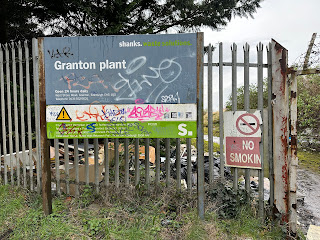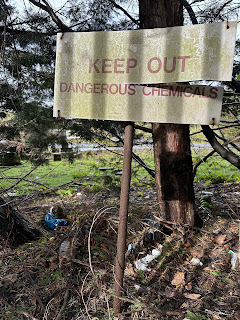I
don’t usually write about battle sites, or even tend to visit them, because
they tend to be pretty f*cking boring places.
Yet, having said that, on a walk along the old railway path that runs
from Roslin to Loanhead, I came across a memorial to the Battle of Roslin and
found that lurking in the background of events leading up to the battle, there
was a story of thwarted love, jealousy and one man’s desire for revenge. How true the story is I don’t know, but hey,
as they say, why let the truth get in the way of a good yarn!
Memorial to the Battle
of Roslin
Way
back in time, in 1303, when the world was a wild violent place with various
factions and power-hungry men spilling blood everywhere in their fight for
power (nothing changes much), Scotland was in political turmoil. It had been occupied by the English since
1298, after the defeat of the Scots army at the battle of Falkirk, and was governed
by Sir John de Segrave, a knight of the English king, Edward I.
While
he was in Scotland, Sir John based himself in Edinburgh Castle, where he
frequently held functions and official gatherings for the local aristocracy,
warlords, people of influence and such like.
One of those who regularly attended at the castle was Lady Margaret
Ramsey of Dalhousie. Sir John was soon
besotted with her and hoped to take her as his wife. Unfortunately, for poor Sir John, his
feelings were not reciprocated, and he was spurned by Lady Margaret who instead
accepted a proposal of marriage from Henry St Clair, the Lord of Rosslyn.
Sir
John was not a happy chap when he learnt of this and flew into a bit of a
rage. So, off he stormed to King Edward to
ask permission to raise an army to eliminate the ‘threat’ that the marriage
between Margaret and Henry would represent.
Edward, who was a bit of a bloodthirsty old sod and always liked an
excuse for a bit of killing and maiming, granted Sir John his wish and he was
soon on his way back to Scotland with an army of 30,000 troops. I do have to point out here that the number
of troops may actually have been grossly exaggerated in the tales told after
the battle, but that’s the figure I’ll run with in my telling of this little
bit of history.
On
arriving in Scotland, Sir John split his army into three separate divisions. Ten thousand troops marched off to attack
Borthwick Castle near Gorebridge, another ten thousand marched off to seize
Dalhousie Castle, the home of Lady Margaret, and the last ten thousand, led by
Sir John himself, marched towards Roslin and the home of Henry St Clair.
On
the evening of the 23 February 1303, Sir John and his troops set up camp near
Roslin for the night, with the intention of giving Henry St Clair a good
thrashing the next day. However, word of the movement of the English forces had
reached the Scots and an army led by John Comyn and Sir Simon Fraser marched through
the night from Biggar down towards Roslin, where they hid until just before dawn
in the nearby woods at Bilston. Then,
early in the morning of the 24 February, as Sir John and his army still slept, the
Scots attacked them. The English troops
were slaughtered, with no mercy being shown to anyone. Well, that was unless you were of noble birth,
in which case you could be held and ransomed for a tidy sum of cash which is
what happened to Sir John and a group of his knights, who were captured and
held prisoner.
Over
the next couple of days bloody skirmishes, slaughters and attacks took place between
the Scots and the other two divisions of Sir John’s army. During one of these, Sir John was freed by
his troops, and deciding to cut his losses, marched the remains of his army
back to England. According to the
legends that grew up around the Battle of Roslin, only two thousand of the
thirty thousand English troops who marched into Scotland with Sir John survived. The rest lay dead and buried in mass graves
in the fields and woods around Roslin. As
the Ballad of the Battle of Roslin recounts, their bones would occasionally be
dragged up when the fields they lay in were ploughed -
An farmers tae this very day,
When they’re at the ploo-in,
Still find shinbanes in the clay,
At the place they call ‘The Hewin…
Site of the Battle of
Roslin
Memorial to the Battle
of Roslin
Pylons at the site of
the Battle of Roslin
So,
what, you may ask, happened to all the main players after the battle. Well, the hero of the hour, John Comyn, was
murdered a few years later by Robert the Bruce when the two of them fell
out. Bruce stabbed him to death by the high
altar at Greyfriars Church in Dumfries.
Sir
Simon Fraser also died a few years after the battle when he was captured and
taken prisoner by the English army. On
King Edward’s orders, he was taken to London and there was hung, drawn, and
quartered, with his head stuck on a spike on London Bridge.
Sir
John de Segrave lived a long and eventful life, he took William Wallace prisoner
and escorted him down to London to be executed, he was then himself a prisoner
in Scotland for a couple of years after the Battle of Bannockburn, was freed
after a ransom was paid, acquired various lands around England, was appointed
as the Seneschal of Gascony, and died an old man while looking after the King’s
interests there.
As
for Lady Margaret Ramsey of Dalhousie, well her story is either lost in the
mists of time, which given the lack of records relating to women’s lives in
that era is quite possible, or she never existed and was purely made up as a
love interest to add a bit of oomph to the tale of the Battle of Roslin.
While
out on my walk through the once bloodstained lands where so many men died, I
left a Skulferatu in a gap in the wall around the monument to this now almost
forgotten battle.
Skulferatu #109
Skulferatu #109 in a gap
in the monument wall
Skulferatu #109 in a gap
in the monument wall
Map showing the location
of Skulferatu #109
The
coordinates for the location of the Skulferatu are –
Latitude
55.862858
Longitude
-3.154724
what3words:
inferior.unheated.dolls
I
used the following sources for information on the Battle of Roslin –
Historic Scotland
The Inventory of Historic Battlefields – Battle
of Roslin
The Scotsman - Roslin 1303: Scotland's
forgotten battle
24 February 2017




















































